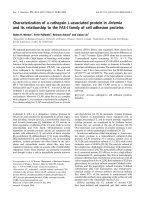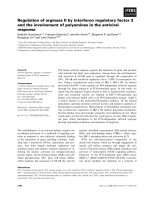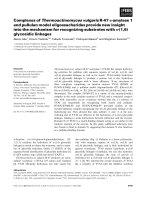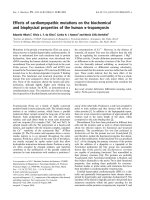Báo cáo khoa học: "Impact of the frequency of online verifications on the patient set-up accuracy and set-up margin" ppt
Bạn đang xem bản rút gọn của tài liệu. Xem và tải ngay bản đầy đủ của tài liệu tại đây (259.3 KB, 7 trang )
RESEARCH Open Access
Impact of the frequency of online verifications on
the patient set-up accuracy and set-up margins
Volker Rudat
1*
, Mohamed Hammoud
1
, Yogin Pillay
1
, Abdul Aziz Alaradi
1
, Adel Mohamed
1
and Saleh Altuwaijri
2
Abstract
Purpose: The purpose of the study was to evaluate the patient set-up error of different anatomical sites, to
estimate the effect of different frequencies of online verifications on the patient set-up accuracy, and to calculate
margins to accommodate for the patient set-up error (ICRU set-up margin, SM).
Methods and materials: Alignment data of 148 patients treated with inversed planned intensity modulated
radiotherapy (IMRT) or three-dimensional conformal radiotherapy (3D-CRT) of the head and neck (n = 31), chest (n
= 72), abdomen (n = 15), and pelvis (n = 30) were evaluated. The patient set-up accuracy was assessed using
orthogonal megavoltage electronic portal images of 2328 fractions of 173 planning target volumes (PTV). In 25
patients, two PTVs were analyzed where the PTVs were located in different anatomical sites and treated in two
different radiotherapy courses. The patient set-up error and the corresponding SM were retrospectively determined
assuming no online verification, online verification once a week and online verification every other day.
Results: The SM could be effectively reduced with increasing frequency of online verifications. However, a
significant frequency of relevant set-up errors remained even after online verification every other day. For example,
residual set-up errors larger than 5 mm were observed on average in 18% to 27% of all fractions of patients
treated in the chest, abdomen and pelvis, and in 10% of fractions of patients treated in the head and neck after
online verification every other day.
Conclusion: In patients where high set-up accuracy is desired, daily online verifica tion is highly recommended.
Introduction
Linear accelerators capable of image-guided radiother-
apy (IGRT) have become available in a large number of
institutions. With the new on-board imaging technolo-
gies, patient positioning verification has become more
accurate [1,2]. IGRT also offers the opportunity of fre-
quent online treatment verification in the clinical rou-
tine, which may lead to modifications of verification
protocols popular in the pre-IGRT era.
The frequency of online verifications should generally
be as low as necessary to achieve the desired patient
positioning accuracy in order to save machine-time and
imaging dose to the patient. At the same time, the safety
margin to accommodate for the patient positioning
error should be as small as possible in order to reduce
the dose to normal tissue.
The International Commission on Radiation Units and
Measurements (ICRU) has defined two margins to com-
pensate for geometric variation and uncertainties that
may impede the exact delivery of a treatment plan: The
Internal margin (IM) and set-up margin ( SM). The IM
accounts for expected organ motion and deformation,
and the SM for patient set-up errors due to variations
in the daily positioning of the patient on the treatment
couch. Mechanical uncertainties of the equipment (e.g.,
sagging of the couch), dosimetric uncertainties, transfer
set-up errors from CT-Simulator to the treatment unit,
and human related errors also contribute to t he SM.
The planning target volume (PTV) encompasses the
clinical target volume (CTV), the IM, and SM.
In this study we measured the set-up error of patients
treated in the head and neck region, chest, abdomen,
and pelvis by using electronic portal imaging. In addi-
tion, the effect of different frequencies of online verifica-
tion (no online verification, online verification once a
week, online verification every other day) on the patient
* Correspondence:
1
Department of Radiation Oncology, Saad Specialist Hospital, P.O. Box 30353,
Al Khobar 31952, Saudi Arabia
Full list of author information is available at the end of the article
Rudat et al. Radiation Oncology 2011, 6:101
/>© 2011 Rudat et al; licensee BioMed Central Ltd. This is an Open Access article distributed under the terms of the Creative Commons
Attribution License (htt p://creativecommons.org/licenses/by/2.0), which permits unrestricted use, distribution, an d reproduction in
any medium, provided the original work is properly cited.
set-up error was evaluated, an d for each scenario the
corresponding SM calculated.
The data should help the physician to choose the
most clinically appropriate frequency of online verifica-
tion for the individual patient by bal ancing the “cost” of
online verification (machine-time and imaging dose to
the patient) with the risk of radiation toxicity related to
the size of the PTV.
Methods and materials
One hundred and forty-eight patients treated with
inversed planned intensity modulated radiotherapy
(IMRT) or three-dimensional conformal radiotherapy
(3D-CRT) of the head and neck (n = 31), chest (n =
72), abdomen (n = 15), and pelvis (n = 30) were evalu-
ated. Patients treated in a belly board were excluded
from the analysis because the set-up error in prone
position has been shown to be significantly larger com-
pared to supine position [3,4]. The patient set-up error
was assessed using orthogonal electronic portal im ages
of 2328 fractions of 173 planning target volumes (PTV).
In 25 patients, two PTVs were analyzed where the
PTVs were located in different anatomical sites and
treated in two different radiotherapy courses. Electronic
portal images were taken daily of all patients where a
high dose was prescribed and organs at risk were
located in close proximity to the PTV (all patients trea-
ted with IMRT and selected patients treated with 3D-
CRT; n = 60 [35%]). For all other patients, electronic
portal images were taken on days 1-3, t hen every other
day (n = 113 [65%]). The average number of fractions
with electronic portal images per PTV was 13, and the
range was 3 to 43.
Patient immobilization and treatment planning
All patients treated in the head and neck region were
immobilized using a thermoplastic mask in a carbon
frame, and a kneefix. Patients treated in the chest were
immobilized using a Silverman headrest, wing board or
C-Qual breastboard, and a kneefix. Patients treated in
the abdomen or pelvis were immobilized using a Silver-
man headrest, kn eefix, and feetfix. The CT-Simulator,
the PET-CT, and the linear accelerators were equipped
with identical models of a carbon index tables, and posi-
tioning d evices (CIVCO, Iowa, U.S.A.). The CT-simula-
tor and the PET-CT were equipped with red lasers, the
linear accelerators with green lasers.
CT-Simulation was performed using a CT Simulator
(Somatom Sensation Open, Siemens Medical, Germany)
or PET-CT (Biograph 64, Siemens Medical, Germany).
The slice thickness was 3 mm or 5 mm. The CT scan-
ning reference point and t arget volumes (PTV and
organs at risk) were d efined using specific software
(Coherence Therapist and Coherence Oncologist,
Siemens Medical, Germany). The IMRT and 3D-CRT
plans were generated using the treatment planning sys-
tem XIO 4.4 (CMS, Inc. of St. Louis, Mo, USA). Linear
accelerators (Oncor Avant Garde, Siemens Medical,
Germany) with dual photon energy of 6 MV and 15
MV, multileaf collimator (80 leaves, after upgrade 160
leaves), and EPID (Optivue, Siemen Medical, Germany)
were used for the treatment.
Online treatment verification
Orthogonal megavoltage electronic portal images were
generated prior to treatment. Processing and analysis
software was used to significantly improve the image
quality of the megavoltage electronic portal images [1].
Representative bony landmarks as recommended by the
report “On target: ensuring geometric accuracy in radio-
therapy ” by The Royal College of Radiologists [5] and in
addition the trachea in chest patien ts [6] were marked
using electronic drawing tools and compared with corre-
sponding digitally reconst ructed radiographs generated
by the treatment planning system. Images were zoomed
and electronically superposed. The portal imaging soft-
ware calculated the deviation of the corresponding iso-
centers. Online correction was done by automatic
adjustment of the treatment table in three dimensio ns
prior to treatment. Repeated portal images were taken
after table correction for the first 20 patients. Thereafter,
this practice was discontinued because the automatic
table correction showed to be consistently precise.
Statistical Analysis
Individual and population based patient positioning
accuracy parameters were calculated according to the
report “On target: ensuring geometric accuracy in radio-
therapy” by The R oyal College of Radiologists [5].
Accordingly, the individual mean set-up error M
individual
was defined as the mean set-up error f or an individual
patient. The overall population mean set-up erro r M
pop
was defined as the overall mean for the analyzed patient
group. The population systematic error Σ
set-up
was
defined as the standard deviation of the in dividual mean
set-up error about the overall mean M
pop
.Theindivi-
dual random (daily) set-up error s
individual
was defined
as the standar d deviation of the set-up error around the
corresponding mean individual value M
individual
.The
population random error s
set-up
was defined as the
mean of all individual random errors s
individual
.
The patient set-up accuracy parameters for each direc-
tion (anteroposterior, lateral and superoinferior) were
calculated for patients treated in the head a nd neck
region,chest,abdomen,andpelvisseparately.Amulti-
variate analysis of variance (ANOVA) and the Bonfer-
roni test for post-hoc comparison were performed to
test for statistically significant differences of the
Rudat et al. Radiation Oncology 2011, 6:101
/>Page 2 of 7
systematic and random set-up error of patients treated
in the different anatomical regions. For the ANOVA,
M
individual
and s
individual
were used as dependent vari-
ables, the anatomical region (head and neck, chest,
abdomen, and pelvis), and the direction (anteroposterior,
lateral, and superoinferior) as categorical factors.
In order to estimate the patient set-up accuracy with-
out online verification, online verification once p er
week, and online verification every other day, the patient
set-up parameters were retrospectively calculated
assuming a patient set-up error of 0 mm in all direc-
tions after online correction. Due to possible hardware
and software related inaccuracies, the true set-up error
after online correction will be more than 0 mm. How-
ever, phantom measure ments assessing the precision of
laser alignments in our department showed that all
deviations of the reference point at the linear accelerator
compared to the CT simulation reference point were
below 1 mm (data not shown).
Treatment margins were c alculated using the van
Herk formula [7]. Accordingly, the margin required to
ensure 95% minimum dose to the PTV for 90% of the
patients was given by:
M
ptv
=2.50Σ +1.64σ − 1.64σ
P
(1)
where Σ is the square-root of the quadratic sum of the
standard deviations of all contributing systematic errors,
s the square-root of the quadratic sum of the stan dard
deviations of all contributing random errors, and s
P
the
standard deviation describing the width of the penum-
bra. In our analysis Σ
set-up
was used as contributing sys-
tematic error, and s
set - up
and s
P
as contributing
random errors
σ =
2
σ
2
set−up
+ σ
2
P
. The organ motion,
transfer and delineation errors were not considered in
the calculation of the treatment margins because the
focusofthisstudywasthepatientpositioningset-up
error. The representative standard deviation of the
penumbra width s
P
of our linear accelerators was 4.2
mm.
Residual set-up errors were calculated as percentage of
the total number of measurements above the specified
cut-off. For the calculation of the residual error the
three-dimensional vector of the set-up error was used.
Results
The population based patient set-up parameters without
online verification, online verification once a week, and
online verification every other day are listed in table 1.
Thedatashowaneffectiveimprovementofboththe
systematic and the random error with increasing fre-
quency of online verifications. The systematic error
tended to be smaller than the random error in all
scenarios and improved from no online verification to
online verification every other day relatively more than
the random error (on average by a factor of 2.1 versus
1.4).
An ANOVA with the Bonferroni test for post-hoc
comparison of the patient set-up parameters without
online verific ation showed a signi ficantly smaller patient
set-up random error for patients treated in the head and
neck compared to the patients treated in the chest,
abdomen, or pelvis (p < 0.01). This result was most
probably due to the more effective patient positioning
immobilizati on by mask fixation. No significant different
patient set-up random error was found between the
patients treated in the chest, abdomen, or pelvis in the
three directions: anteroposterior, l ateral, and superoin-
ferior. A small but significant difference of the patient
mean set-up error was found in the lateral direction
(-0.50 mm) compared to the anteroposterior (0.58 mm)
or superoinferior (0.39 mm) direction (p < 0.01).
Figure 1 shows the frequency of set-up errors larger
than 3 mm, 5 mm, and 10 mm of patients treated in the
head and neck, chest, abdomen, and pelvis. A consider-
able frequency of relevant residual set-up errors even
after online verification every other day was demon-
strated. The marked interindividual variability of the fre-
quency of residual errors larger than 5 mm is
demonstrated in Figure 2.
The mean time for online v erification (acquisition of
orthogonal portal images and set-up correction before
Table 1 Patient set-up error (mm) for each scenario in
three dimensions
Direction
AP Lateral SI
Anatomical region FOV M Σ s M Σ s M Σ s
Head and Neck 0% 0.3 0.9 1.6 -0.3 1.3 1.6 0.6 1.5 2.2
Chest 0% 0.7 2.4 2.7 -0.3 2.2 2.7 0.5 1.7 2.4
Abdomen 0% 0.6 3.0 3.3 -0.9 2.4 3.0 -0.8 3.6 3.1
Pelvis 0% 0.9 2.3 3.2 -0.3 1.8 2.7 1.0 3.2 2.5
Head and Neck 20% 0.2 0.8 1.4 -0.3 1.1 1.4 0.4 1.1 1.9
Chest 20% 0.5 1.7 2.2 -0.3 1.7 2.4 0.3 1.4 2.1
Abdomen 20% 0.6 2.3 3.1 -0.5 1.6 2.7 -0.4 2.6 3.0
Pelvis 20% 0.6 1.7 2.9 -0.4 1.5 2.4 0.9 2.6 2.3
Head and Neck 50% 0.1 0.5 1.1 -0.1 0.6 1.2 0.2 0.6 1.3
Chest 50% 0.3 0.9 1.6 -0.2 1.1 2.0 0.2 0.8 1.6
Abdomen 50% 0.4 1.5 2.5 -0.2 1.1 2.5 -0.4 1.7 2.8
Pelvis 50% 0.5 1.3 2.4 -0.2 1.1 1.9 0.6 1.4 2.0
Abbreviations: M = Overall population mean set-up error; Σ = Population
systematic error; s = Population random error; AP = anteroposterior; SI =
superoinferior; FOV = Frequency of online verifications; 0% = No online
verification; 20% = Online verification once a week; 50% = Online verification
every other day.
Rudat et al. Radiation Oncology 2011, 6:101
/>Page 3 of 7
treatment if necessary) was 3.6 minutes per fraction
(standard deviation 0.5 minutes), and on aver age 4
monitor units per fraction were applied for the portal
imaging.
Table 2 shows that the SM calculated using the van
Herk formula [7] decreased with increasing frequency of
online verification.
Discussion
The purpose of this study was to evaluate the patient
set-up error of different anatomical sites, to estimate the
effect of diff erent frequencies of online verifications on
the patient set-up accuracy, and to calculate the corre-
sponding SM.
Our data show that the patient set-up error improved
effectively with increasing frequency of online verifica-
tion, but that a considerable frequency of relevant set-
up errors remained even after online verification every
other day. For example, residual set-up errors larger
than 5 mm were observed on average in 18% to 27% of
all fractions of patients treated in the chest, abdomen
and pelvis, and in 10% of fractions of patients treated in
the head and neck after online verification every other
day. The higher set-up accuracy of the head and ne ck
region was most probably due to the more e ffective
immobilization using the mask fixation. We conclude
that less than daily online verification may lead to sub-
optimal results in patients where high set-up accuracy is
desi red. Another observation supporting this conclusion
is the marked interindividual v ariability of the patient
set-up accuracy. This may result in a treatment with
clinically unacceptable high frequency of set-up errors
larger than 5 mm in individual patients if population
based safety margins are used and online verification is
done less than daily. For exam ple, the p atient with the
worst patient positioning accuracy in our study had a
frequency of displacements larger than 5 mm i n 50% of
all fractions after online verification every other day.
The frequency of set-up errors above a certain level
that can be tolerated is a clinical decision involving fac-
tors associated with prognosis, risk of failure, and toxi-
city. The calculation of the safety margin based on the
Figure 1 Frequency of set-up errors larger than threshold (three-dimensional vector) for all scenarios and all f ractions. The frequency
of online verifications is plotted on the horizontal axis (0%, no online verification; 20%, online verification once a week; 50%, online verification
every other day), and the percentage of fractions with set-up errors larger than 3 mm, 5 mm or 10 mm on the vertical axis.
Rudat et al. Radiation Oncology 2011, 6:101
/>Page 4 of 7
patient set-up accuracy after different frequencies of
online verifications would enable the radiation o ncolo-
gist to select the most appropriate approach in terms of
size of the PTV versus cost associated with imaging in
terms of in-room time and imaging dose to the patient.
In our institution we decided to perform daily online
verifications in all patients treated with IMRT and in
patients treated with 3D-CRT where a high dose is pre-
scribed and critical organs at risk are located in close
proximity to the PTV. Patients, for example, where the
prescribed dose does not exceed the tolerance dose of
relevant organs at risk may be treated with a lower fre-
quency of online verifications and with a correspond-
ingly larger PTV. The “cost” of in-room time observed
in our study of 3.6 minutes (standard deviation 0.5 min-
utes) per patient and fraction was considered acceptable.
Furthermore, imaging dose to the patient is minimal if
portal imaging is used compared to cone-beam com-
puted tomography (CBCT), and lower if kilovoltage X-
rays are used compared to megavoltage X-rays [8].
Figure 2 Interindividual variability of frequencies of set-up errors larger than 5 mm (three-dimensional vector). The frequency of online
verifications is plotted on the horizontal axis (0%, no online verification; 20%, online verification once a week; 50%, online verification every
other day), and the percentage of fractions with set-up errors larger 5 mm on the vertical axis.
Table 2 Set-up margins (mm) for each scenario using the
van Herk formula [3]
Safety Margin*
Anatomical region FOV AP Lateral SI
Head and Neck 0% 3 4 5
Chest 0% 7 7 5
Abdomen 0% 9 8 11
Pelvis 0% 8 6 9
Head and Neck 20% 2 3 3
Chest 20% 5 5 4
Abdomen 20% 7 5 8
Pelvis 20% 6 5 7
Head and Neck 50% 1 2 2
Chest 50% 3 3 2
Abdomen 50% 5 4 6
Pelvis 50% 4 3 4
Abbreviations: * = 95% of the dose for 90% of the patients; other
abbreviations as in Table 1.
Rudat et al. Radiation Oncology 2011, 6:101
/>Page 5 of 7
We analyzed the patient set-up accuracy using the
concept of systematic and random error s. The systema-
tic component of any errors can be defined as a devia-
tion that occurs in the same direction and is of a similar
magnitude for each fraction throughout the treatment
course ("treatment preparation errors” ), and the random
component as a deviation that can vary in direction and
magnitude for each delivered treatment fraction ("treat-
ment execution errors”). The differentiation between
systematic and random errors is not only important to
identify sources of errors, it is also important for the
derivation of appropriate safety margins. Typically the
key contributor to the margin is the combine d systema-
tic error. Using the van Herk formula [7] with the
assumption to cover the PTV with ≥95% of the pre-
scribed dose in 90% of the patients, the SM of the dif-
ferent anatomical sites and directions could be reduced
from 3-11 mm without online verification to 1-6 mm
after online verification every other day. It should be
noted that these safety margins have to be considered as
minimum margins because the delineation error, trans-
fer e rror, and organ motion were not considered in o ur
analysis. In addition, possible rotational errors and
changes of the shape o f the tumor during radiotherapy
are ignored by the van Herk model [7].
The systematic and random patient set-up errors
observed in our study are well in line with correspond-
ing published reports [3,9-33]. The impact of daily
online verificati on on the P TV has been e xtensively
studied in p atients treated with definitive radiotherapy
for prostate cancer. For this tumor entity, the target
positioning accuracy is of paramount importance
because of the high dose prescribed, the close proxi-
mity of the organs at risk: bladder and rectum to the
prostate, and the use of the highly conformal treat-
ment technique IMRT. Image-guided radiotherapy
(IGRT) using fiducial prostate markers, in-room CT,
or cone-beam CT were used to control for the prostate
motion. All reports showed that daily online verifica-
tion permits the use of narrower CTV-PTV margins
without compromising coverage of the target
[23,25-32]. Ku pelian et al. retrospectively compa red
different image-guided strategies in the alignment of
prostate cancer patients using fiducial prostate gold
markers. The authors showed that the systematic error
was effectively reduced with imaging, but that the
magnitude of random errors remained una ffected at
the treatment sessions not associated with image gui-
dance. In line with our results, a significant frequency
of relevant residual errors was found even after online
verification every other day, and the authors suggested
that daily localizations should be performed in the set-
up of prostate cancer patients during a course of exter-
nal beam radiotherapy [27].
The focus of our analysis was the patient set-up accu-
racy. Geometric uncertainties due to organ motion were
not analyzed in this study. Therefore an IM has to be
added to the SM proposed in our study to define the
PTV [7,34].
However, the ultimate goal would be to achi eve the
planned dose distribution. The most precise approach to
accomplish this goal would be the use of daily kilovol-
tage CT-based online verification with excellent soft-tis-
sue image quality, delineation of all relevant structures,
and online recalculation of plan parameters if necessary
[2]. Technologies are currently under development that
will allow this approach in a time and workflow feasi ble
for clinical routine application.
Conclusions
The ICRU set-up margin (SM) could be reduced with
incr easing frequency of online verification but a consid-
erable frequency of relevant set-up errors remain even
after online verification every other day. For example,
residual set-up errors larger than 5 mm were observed
on average in 18% to 27% of all fractions of patients
treated in the chest, abdomen, and pelvis, and in 10% of
fractions of patients treated in the head and neck after
online verification every other day. We conclude that in
patients where high set-up accuracy is desired, daily
online verification is highly recommended.
List of abbreviations
3D-CRT: Three-dimensional conformal radiotherapy; ANOVA: Multivariate
analysis of variance; EPID: Electronic portal imaging device; IGRT: Image-
guided radiotherapy; IM: ICRU internal margin; IMRT: Inversed planned
intensity modulated radiotherapy; PTV: Planning target volume; SM: ICRU set-
up margin
Author details
1
Department of Radiation Oncology, Saad Specialist Hospital, P.O. Box 30353,
Al Khobar 31952, Saudi Arabia.
2
SAAD Research & Development Center, Saad
Specialist Hospital, P.O. Box 30353, Al Khobar 31952, Saudi Arabia.
Authors’ contributions
MH, YP, AA, and AM participated in the study design, contributed to the
data collection, and helped to draft the manuscript. SA participated in its
design and coordination and helped to draft the manuscript. VR conceived
of the study, participated in its design and coordination, participated in the
treatment panning, performed the statistical analysis, and drafted the
manuscript. All authors read and approved the final manuscript.
Competing interests
The authors declare that they have no competing interests.
Received: 12 May 2011 Accepted: 24 August 2011
Published: 24 August 2011
References
1. Kirby MC, Glendinning AG: Developments in electronic portal imaging
systems. Br J Radiol 2006, 79(Spec No 1):S50-65.
2. Boda-Heggemann J, Lohr F, Wenz F, Flentje M, Guckenberger M: kV Cone-
Beam CT-Based IGRT: A Clinical Review. Strahlenther Onkol 2011.
3. Rudat V, Flentje M, Engenhart R, Metzger M, Wannenmacher M: [The belly-
board technic for the sparing of the small intestine. Studies on
Rudat et al. Radiation Oncology 2011, 6:101
/>Page 6 of 7
positioning accuracy taking into consideration conformational irradiation
technics]. Strahlenther Onkol 1995, 171(8):437-443.
4. Siddiqui F, Shi C, Papanikolaou N, Fuss M: Image-guidance protocol
comparison: supine and prone set-up accuracy for pelvic radiation
therapy. Acta Oncol 2008, 47(7):1344-1350.
5. Radiologists TRCo: On target: ensuring geometric accuracy in
radiotherapy. London: The Royal College of Radiologists, Society and
College of Radiographers, Institute of Physics and Engineering in Medicine.;
2008.
6. Higgins J, Bezjak A, Franks K, Le LW, Cho BC, Payne D, Bissonnette JP:
Comparison of spine, carina, and tumor as registration landmarks for
volumetric image-guided lung radiotherapy. Int J Radiat Oncol Biol Phys
2009, 73(5):1404-1413.
7. van Herk M, Remeijer P, Rasch C, Lebesque JV: The probability of correct
target dosage: dose-population histograms for deriving treatment
margins in radiotherapy. International Journal of Radiation
Oncology*Biology*Physics 2000, 47(4):1121-1135.
8. Walter C, Boda-Heggemann J, Wertz H, Loeb I, Rahn A, Lohr F, Wenz F:
Phantom and in-vivo measurements of dose exposure by image-guided
radiotherapy (IGRT): MV portal images vs. kV portal images vs. cone-
beam CT. Radiother Oncol 2007, 85(3):418-423.
9. Rudat V, Flentje M, Oetzel D, Menke M, Schlegel W, Wannenmacher M:
Influence of the positioning error on 3D conformal dose distributions
during fractionated radiotherapy. Radiother Oncol 1994, 33(1):56-63.
10. Rudat V, Schraube P, Oetzel D, Zierhut D, Flentje M, Wannenmacher M:
Combined error of patient positioning variability and prostate motion
uncertainty in 3D conformal radiotherapy of localized prostate cancer.
Int J Radiat Oncol Biol Phys 1996, 35(5):1027-1034.
11. Budrukkar A, Dutta D, Sharma D, Yadav P, Dantas S, Jalali R: Comparison of
geometric uncertainties using electronic portal imaging device in focal
three-dimensional conformal radiation therapy using different head
supports. J Cancer Res Ther 2008, 4(2):70-76.
12. Gupta T, Chopra S, Kadam A, Agarwal JP, Devi PR, Ghosh-Laskar S,
Dinshaw KA: Assessment of three-dimensional set-up errors in
conventional head and neck radiotherapy using electronic portal
imaging device. Radiat Oncol 2007, 2:44.
13. Nelson C, Starkschall G, Balter P, Morice RC, Stevens CW, Chang JY:
Assessment of lung tumor motion and setup uncertainties using
implanted fiducials. Int J Radiat Oncol Biol Phys 2007, 67(3):915-923.
14. Pehlivan B, Pichenot C, Castaing M, Auperin A, Lefkopoulos D, Arriagada R,
Bourhis J: Interfractional set-up errors evaluation by daily electronic
portal imaging of IMRT in head and neck cancer patients. Acta Oncol
2009, 48(3):440-445.
15. Samson MJ, van Sornsen de Koste JR, de Boer HC, Tankink H, Verstraate M,
Essers M, Visser AG, Senan S: An analysis of anatomic landmark mobility
and setup deviations in radiotherapy for lung cancer. Int J Radiat Oncol
Biol Phys 1999, 43(4):827-832.
16. Santanam L, Esthappan J, Mutic S, Klein EE, Goddu SM, Chaudhari S,
Wahab S, El Naqa IM, Low DA, Grigsby PW: Estimation of setup
uncertainty using planar and MVCT imaging for gynecologic
malignancies. Int J Radiat Oncol Biol Phys 2008, 71(5):1511-1517.
17. Smith S, Yartsev S, Van Dyk J:
Evaluation of megavoltage CT imaging
protocols in patients with lung cancer. J Med Imaging Radiat Oncol 2010,
54(1):62-68.
18. Venables K, Miles EA, Hoskin PJ, Aird EG: Verification films: a study of the
daily and weekly reproducibility of breast patient set-up in the START
trial. Clin Oncol (R Coll Radiol) 2005, 17(5):337-342.
19. Wu J, Haycocks T, Alasti H, Ottewell G, Middlemiss N, Abdolell M, Warde P,
Toi A, Catton C: Positioning errors and prostate motion during conformal
prostate radiotherapy using on-line isocentre set-up verification and
implanted prostate markers. Radiother Oncol 2001, 61(2):127-133.
20. Alasti H, Petric MP, Catton CN, Warde PR: Portal imaging for evaluation of
daily on-line setup errors and off-line organ motion during conformal
irradiation of carcinoma of the prostate. Int J Radiat Oncol Biol Phys 2001,
49(3):869-884.
21. Greer PB, Dahl K, Ebert MA, Wratten C, White M, Denham JW: Comparison
of prostate set-up accuracy and margins with off-line bony anatomy
corrections and online implanted fiducial-based corrections. J Med
Imaging Radiat Oncol 2008, 52(5):511-516.
22. Johnston ML, Vial P, Wiltshire KL, Bell LJ, Blome S, Kerestes Z, Morgan GW,
O’Driscoll D, Shakespeare TP, Eade TN: Daily Online Bony Correction is
Required for Prostate Patients Without Fiducial Markers or Soft-tissue
Imaging. Clin Oncol (R Coll Radiol) 2011.
23. Schallenkamp JM, Herman MG, Kruse JJ, Pisansky TM: Prostate position
relative to pelvic bony anatomy based on intraprostatic gold markers
and electronic portal imaging. Int J Radiat Oncol Biol Phys 2005,
63(3):800-811.
24. Ludbrook JJ, Greer PB, Blood P, D’Yachkova Y, Coldman A, Beckham WA,
Runkel J, Olivotto IA: Correction of systematic setup errors in prostate
radiation therapy: how many images to perform? Med Dosim 2005,
30(2):76-84.
25. Schiffner DC, Gottschalk AR, Lometti M, Aubin M, Pouliot J, Speight J,
Hsu IC, Shinohara K, Roach M: Daily electronic portal imaging of
implanted gold seed fiducials in patients undergoing radiotherapy after
radical prostatectomy. Int J Radiat Oncol Biol Phys 2007, 67(2):610-619.
26. Barney BM, Lee RJ, Handrahan D, Welsh KT, Cook JT, Sause WT: Image-
Guided Radiotherapy (IGRT) for Prostate Cancer Comparing kV Imaging
of Fiducial Markers With Cone Beam Computed Tomography (CBCT). Int
J Radiat Oncol Biol Phys 2011, 80(1):301-305.
27. Kupelian PA, Lee C, Langen KM, Zeidan OA, Manon RR, Willoughby TR,
Meeks SL: Evaluation of image-guidance strategies in the treatment of
localized prostate cancer. Int J Radiat Oncol Biol Phys 2008,
70(4):1151-1157.
28. Litzenberg DW, Balter JM, Hadley SW, Sandler HM, Willoughby TR,
Kupelian PA, Levine L: Influence of intrafraction motion on margins for
prostate radiotherapy. Int J Radiat Oncol Biol Phys 2006, 65(2):548-553.
29. van Haaren PM, Bel A, Hofman P, van Vulpen M, Kotte AN, van der
Heide UA: Influence of daily setup measurements and corrections on the
estimated delivered dose during IMRT treatment of prostate cancer
patients. Radiother Oncol
2009, 90(3):291-298.
30. Skarsgard D, Cadman P, El-Gayed A, Pearcey R, Tai P, Pervez N, Wu J:
Planning target volume margins for prostate radiotherapy using daily
electronic portal imaging and implanted fiducial markers. Radiat Oncol
2010, 5:52.
31. Chen J, Lee RJ, Handrahan D, Sause WT: Intensity-modulated radiotherapy
using implanted fiducial markers with daily portal imaging: assessment
of prostate organ motion. Int J Radiat Oncol Biol Phys 2007, 68(3):912-919.
32. Millender LE, Aubin M, Pouliot J, Shinohara K, Roach M: Daily electronic
portal imaging for morbidly obese men undergoing radiotherapy for
localized prostate cancer. Int J Radiat Oncol Biol Phys 2004, 59(1):6-10.
33. Hurkmans CW, Remeijer P, Lebesque JV, Mijnheer BJ: Set-up verification
using portal imaging; review of current clinical practice. Radiother Oncol
2001, 58(2):105-120.
34. Stroom JC, Heijmen BJ: Geometrical uncertainties, radiotherapy planning
margins, and the ICRU-62 report. Radiother Oncol 2002, 64(1):75-83.
doi:10.1186/1748-717X-6-101
Cite this article as: Rudat et al.: Impact of the frequency of online
verifications on the patient set-up accuracy and set-up margins.
Radiation Oncology 2011 6:101.
Submit your next manuscript to BioMed Central
and take full advantage of:
• Convenient online submission
• Thorough peer review
• No space constraints or color figure charges
• Immediate publication on acceptance
• Inclusion in PubMed, CAS, Scopus and Google Scholar
• Research which is freely available for redistribution
Submit your manuscript at
www.biomedcentral.com/submit
Rudat et al. Radiation Oncology 2011, 6:101
/>Page 7 of 7









